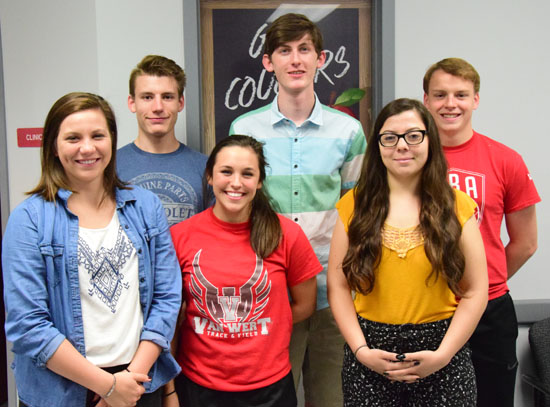VWHS students earn top STEM grades
DAVE MOSIER/independent editor
A recent state competition showed that Van Wert High School’s STEM (Science, Technology, Engineering, Math) programs can compete with any school in Ohio.

Six VWHS students in the school’s Project Lead the Way pre-engineering and biomedical programs competed in this year’s Believe in Ohio STEM Business Plan competition — with outstanding results. The students said they were urged by teacher Bob Spath to enter the competition.
VWHS’s three two-student groups were among more than 6,000 entries in the business plan competition, but all three finished in the top five of their division at the state level.
The local groups, and their STEM competition projects, consisted of Sadie Zartman and Doug Billingham, “Light Up Motion Sensor Outlet Cover”; Domonique Grothause and Katie Trittschuh, “Electronic Patient Information Circlet”; and Nick White and Nick Gorman, “A Safe Route to School.”
As part of the competition, which was created by The Ohio Academy of Science, with support from the Ohio Board of Regents and the 130th Ohio General Assembly, students had to complete business plans for products they created. The competition, which focuses on the practical application of STEM education, included written papers at each level of the competition outlining the plans, as well as an oral presentation and questioning by judges at the state level.
Ohio’s top STEM students competed for scholarships in 10 divisions ranging from $2,500 to $20,000, as well as various cash prizes. The program was developed to help Ohio students understand the importance of STEM education, as well as develop an entrepreneurial mindset to become competitors in Ohio’s Innovation Economy of the future through participation in the STEM Commercialization and Business Plan competitions. The program also hopes to inspire students to become interested in STEM education, since it’s where many of the best jobs and careers can be found.
VWHS results showed that STEM education, which includes robotics programs at the high school, middle school, and elementary levels — as well as the school’s investment in project-based education — has been good for local students, with Zartman and Billingham winning their sensor division, while all three groups finished in the top five of their various divisions.
Zartman and Billingham, who developed a outlet cover that lights up when a person comes within 3 inches of it to avoid bent electrical prongs and outlet damage, will split the top prize of a $20,000 college scholarship between them, money Zartman said would pretty much pay for at least her first year of college at the University of Toledo, along with other scholarships she has received.
Both said they felt the competition was an interesting one, and are now deciding on whether to patent their invention.
Grothause and Trittschuh, who created a wearable electronic circlet that monitors heart rate and other vitals to assist in emergency room and ICU monitoring, were third in their division. The pair noted they had a technical glitch in their oral presentation, but were able to quickly adjust, which earned them positive comments from competition judges.
“They complimented us on our ability to adapt to the situation, and I think a lot of that comes from our experience of (project-based learning) presentations,” Trittschuh said.
Both found the competition to be interesting and were very pleased with where they placed in their division.
“It was interesting because it’s something we have never done before, and the school has never done before,” Grothause noted.
The pair also liked the $5,000 scholarship they split for coming in third in their division.
White and Gorman, although placing the lowest of the three groups, still did very well with a fifth-place finish in their division. They also may have the first project of the three to actually be put into operation, since their idea for a safe route to the school complex on Ohio 118 will be put into operation this fall.
White said their project arose from their pre-engineering classes, where students are tasked to come up with “real world” engineering problem and then find a solution to the problem.
White, who runs track and cross country, said he saw a safety issue with having to travel on foot or by bicycle from school property into town, because most of the streets in the area don’t have sidewalks, forcing students to run, bike, or walk along often busy streets. He and Gorman said they thought having a safe alternate route to school would be beneficial to students.
The pair’s route will run from Ohio 118 at the school to a double-crossing on Fox Road and onto the north side of that street, then east to Westwood Drive, where it will cross the street again and then to areas with sidewalks.
White said he and Gorman had to do some research and other tasks for the project. They decided on materials for the route, had to get the project priced and approved by the city, and also worked with the school administration to get the project approved, and The Van Wert County Foundation, which is helping finance the project.
“We very excited to see the process come to a close, and hope to come back and see a sidewalk in place,” White noted, adding that he and Gorman also won a $1,000 cash prize in the state competition that will come in handy for books and other needs in college.
All three VWHS groups came up with projects that, while doing well in competition with their peers, also could become real devices or projects that could benefit Ohioans and others in the future.
Furthermore, in White and Gorman’s case, the students were able to help the community with a real problem — one that was turned down for a Safe Routes grant from the Ohio Department of Transportation a few years ago and was basically dead, until they revived the idea and made it work.
POSTED: 05/14/16 at 8:11 am. FILED UNDER: News







